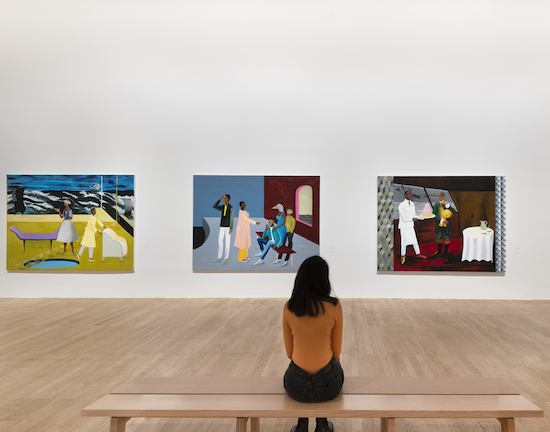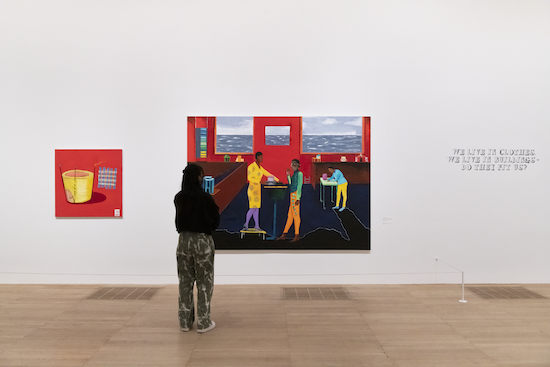Lubaina Himid, Between the Two my Heart is Balanced, 1991, Tate
© Lubaina Himid
The canvas pops with vivid greens, yellows and oranges against a wan, almost abstract, geometric background: a grey triangle, a square of bleached jade. We see a woman at a table with a serrated knife, ten lemons on the surface before her. An additional lemon sits on additional square of wood panelling, hanging off the bottom left hand corner. The work is called Slice Ten Lemons (2020). What, then, to do with the eleventh lemon? It’s like a gift, a pure excess. The woman has her sleeves rolled up and is poised for work, arms stretched out over the table, one grasping the knife, ready to work. But she wears a crown on her head and a line of medals on her chest and her eyes look off, not down at her task, but up and to the side, towards a window in the top left corner of the frame through which we can see the sea.
Scenes like this one abound in the work of Lubaina Himid. People at work, but not necessarily working. We seem to catch them in the act of snaffling some little moment for themselves – to talk to a friend or simply to daydream. Like in Three Architects (2019), a red walled studio in which one of the three titular professionals is hard at work drafting something in the back right of the frame, but her two colleagues front and centre appear to be engaged in conversation – perhaps about each other’s work, but perhaps not. And, again, in the background, through the windows: the sea, which seems to represent something like a space of reverie, the possibility of an elsewhere.
Meanwhile, we hear voices, snatches of music, the creaking of a boat, the lapping of waves. Lubaina Himid’s show at the Tate Modern is more than just an exhibition of paintings. A vivid soundtrack added to many of the works by artist Magda Stawarska-Beavan transforms the experience from a series of things one looks at to an encounter you find yourself engaged in.
The funny thing is, when I sit down to talk to Himid and her collaborator, Stawarska-Beavan, on the fourth floor of the Tate’s Switch House wing, the foundations of their relationship seem to lie in circumstances not that dissimilar from the scenes depicted in Himid’s paintings. “We work in the same university department,” Himid explains. “Magda runs the print room there and I taught students fine art. So we’d come across each other because I’d be talking to students in her print room and she would have to deal with the students that I’d brought there and try and teach them something useful.”

Installation view. Photo credit: (c) Tate (Sonal Bakrania)
“But often we talked about our work as well,” Stawarska-Beavan chips in. “I think we talked more about the art than we talked about students.”
“That is probably so,” Himid agrees. “But I think that was the beginning of how we knew each other: that she was running this incredible space. But then it was clear that she had this huge practice of her own. Then, over the years, we talked about and exchanged ideas. And I felt like I was learning things.”
Himid and Stawarska-Beavan’s relationship goes back more than fifteen years and at times during our conversation I felt almost redundant, so easily did the dialogue flow back and forth between the two of them. They would often finish each other’s sentences, complete each other’s thoughts, and push each other to think deeper in a manner that speaks of close friendship and a long-established working collaboration. What Stawarska-Beavan told me of the interplay of image and sound in the show might easily be said of the thoughts and ideas of the two artists themselves: “It’s almost working like a call-and-response. You look at the paintings, you hear the sounds, you’re playing something back and then you’re seeing something else in the painting. All the time you can add extra layers.
“I think the way sound is in an exhibition space,” she continues, “we’re not blocking one sound from another. They co-exist. Almost the same way you can layer the sound in multi-track editing, but that sort of editing happens in the space.”
“They interweave,” Himid adds. “And even within the sounds, there are moments of silence. Because although sound is absorbed in your body, you can listen and not listen. You can still make space – sonic, silent space for yourself. It’s an interweaving, yes, it’s absolutely not an illustration. And it’s about movement. I think the sound adds an ability for the audience to become performers through the piece, rather than observers. I think somehow sound and music helps us do that. Because it fills the space, I suppose. And gives you some kind of feeling that the visual doesn’t. I think we think of the whole show as a piece – a performance piece, really.”

Installation view. Photo credit: (c) Tate (Sonal Bakrania)
Born in Zanzibar, Lubaina Himid moved to the UK while still a child and studied Theatre Design at Wimbledon College of Art, graduating in 1976. In the 1980s she was a pioneer in the promotion of Black women’s art in the UK, curating shows such as Five Black Women at the Africa Centre in 1983 and Black Woman Time Now at Battersea Arts Centre later in the same year, with the support of the radical Greater London Council. In 2017, by now living within the bounds of another progressive left wing council, in Salford, Greater Manchester, Himid became he first Black woman to win the Turner Prize. The present show is her first major institutional show in London and her largest solo exhibition so far.
“I wanted to make a show where audiences had agency,” Himid tells me, “and I knew that that sound element within a show was going to do that.” Stawarska-Beavan’s involvement in the exhibition seems to have evolved quite organically out of previous collaborations with Himid over the last few years, from working together on a couple of pieces for her show at the New Museum in New York in 2019, to further co-operation (on the work Blue Grid Test) for a 2020 show at Wiels, Brussels. “It just sort of happened naturally,” Stawarska-Beavan confirms, “selecting pieces of work, and then developing it, testing it…”
Stawarska-Beavan’s own work frequently make use of field recordings and spoken voices – including, sometimes, Himid’s. She tells me that even when working on a commissioned piece for one of Himid’s works, “there is so much freedom that sometimes it’s very difficult to differentiate between if I’m doing it for the piece as a soundtrack or if it’s my own work. I always used to talk about my own work with Lubaina so the dialogue goes on all the time. It’s sometimes difficult to make that differentiation if the work is my own or in response to Lubaina because there is this ongoing conversation.”
But at the heart of Stawarska-Beavan’s work lie processes of listening and dialogue through listening. “I was quite interested in forcing people to listen,” she says. “In some of the projects where I ask people to participate and listen to something back; listening to their internal, audible memories, and try to get something out of that.”
“We call it inner listening, don’t we?” Himid adds. “You find yourself, when working with Magda on her projects, remembering things that you were never asked to remember, but because you’ve been prompted by a composition of sound, it does that to you – and it’s quite extraordinary. In a sense, I’m trying to do the same thing with the paintings.”
How is it different, I ask, that process, between a painting and a piece of music?
“I think with painting it works if you leave space,” Himid says, “for the audience as protagonists to enter. If you put too much precise and personal detail and narrative into a painting, it’s then very hard for somebody looking at it to relate to it, because it seems too much like your suit or your bedroom or your life, so if I haven’t worn your suit or tidied up in your bedroom, then it’s like, ooh, it’s all about you. Whereas, if you paint in such a way that it could be my experience after a day’s work and your experience after a day’s work, somehow, then there’s room for you in my painting. But I don’t know about sound. Again, I think it’s about space.”
“We hear all the time,” Stawarska-Beavan says. “But if you start training yourself in listening, then you can filter things and focus on a certain part of the sonic space around you. I think sound has got that really interesting way to be able to trigger the memory – maybe in certain ways can be easier than in painting.”
Lubaina Himid is at Tate Modern until 3 July 2022


